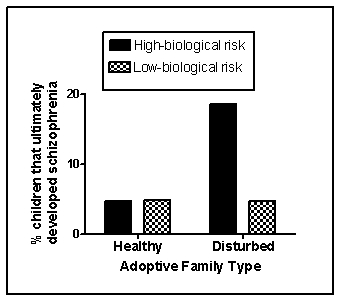Scenario II
The following scenario presents fabricated data consistent with the results of the following study:
Tienari, P., Wynne, L. C., Sorri, A., Lahti, I., Läksy, K., Moring, J., & ... Wahlberg, K. (2004) . Genotype-environment interaction in schizophrenia-spectrum disorder: Long-term follow-up study of Finnish adoptees. The British Journal of Psychiatry, 184(3) , 216-222. doi:10.1192/bjp.184.3.216
Schizophrenia affects approximately 1 percent of the general population and is characterized by the profound disruption of basic psychological processes; a distorted perception of reality;, altered or blunted emotional affect; and disturbances in thought, motivation, and behavior. The symptoms of schizophrenia are varied and are typically classified as either positive or negative. Positive symptoms of schizophrenia refer to thoughts and behaviors typically not observed in those without the disease, and can include things like delusions (patently false beliefs) , hallucinations (false perceptual experiences) , and disorganized speech. Negative symptoms of schizophrenia are deficits or disruptions in normal behaviors, such as social withdrawal. Cognitive deficits in executive functioning, attention span, and working memory also may be observed.
The symptoms of schizophrenia usually begin in late adolescence and the disease has a strong genetic component. Over the years, a number of biological factors have been linked to schizophrenia, although none alone adequately accounts for the disorder. One such example is the dopamine hypothesis, which states that schizophrenia is related to an excess in dopamine activity. Another theory points to enlarged brain ventricles and progressive cortex tissue loss as predictive of schizophrenia, although only a minority of persons with schizophrenia have enlarged ventricles, this structural anomaly can appear in those without the disease, and dopamine antagonists also may produce this effect.
Although research into the environmental determinants of schizophrenia has focused largely on the prenatal environment, psychological and social factors also contribute. Tienari et al. (2004) compared the risk of developing schizophrenia in children adopted into healthy versus disturbed families, the latter characterized by extreme conflict, volatile relationships, and communication deficits. Some of these children under investigation were identified as at-risk genetically for schizophrenia because their biological mothers were schizophrenic. The remainder was classified at low risk. The investigators utilized a longitudinal design and obtained the diagnostic status of the children with respect to schizophrenia when they reached young adulthood. Fabricated results consistent with this study are shown in Figure 15.2
Figure 15.2 
-(Scenario II) Numerous studies have demonstrated enlarged ventricles in patients with schizophrenia, particularly those exhibiting the negative symptoms of the disease. Interpretation of this finding is complicated for all of these reasons EXCEPT:
Definitions:
Machine-Hours
A measure of production output or activity level based on the number of hours machines are operated.
Unused Capacity
The portion of a company’s resources or capabilities that are not currently utilized or producing income.
Capacity
The maximum output that a company can produce under normal conditions over a certain period.
Predetermined Overhead Rate
A rate calculated at the beginning of a period, used to allocate overhead costs to products based on a particular activity base.
Q12: (Scenario II) A war veteran receiving systematic
Q14: Avoidance motivation most closely corresponds to:<br>A)conscientiousness.<br>B)rational coping.<br>C)the
Q35: CBT has been found to be extremely
Q61: Psychoanalysis assumes that we are born with
Q72: All of these are antipsychotic medications EXCEPT:<br>A)Thorazine.<br>B)Haldol.<br>C)Mellaril.<br>D)Paxil.
Q77: A clinically significant psychological or physiological response
Q78: Due to their side effects, MAOIs are
Q93: Psychodynamic approaches to therapy emphasize _; humanistic
Q94: Approximately what percentage of U.S. adults have
Q149: Situation-related anxiety is:<br>A)a symptom that one of